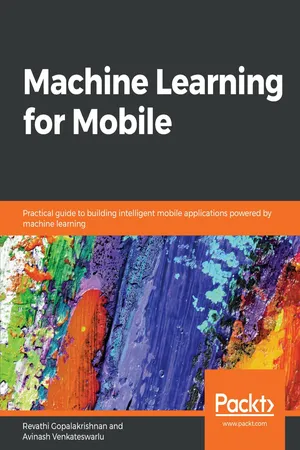
Machine Learning for Mobile
Practical guide to building intelligent mobile applications powered by machine learning
- 274 pages
- English
- ePUB (mobile friendly)
- Available on iOS & Android
Machine Learning for Mobile
Practical guide to building intelligent mobile applications powered by machine learning
About This Book
Leverage the power of machine learning on mobiles and build intelligent mobile applications with ease
Key Features
- Build smart mobile applications for Android and iOS devices
- Use popular machine learning toolkits such as Core ML and TensorFlow Lite
- Explore cloud services for machine learning that can be used in mobile apps
Book Description
Machine learning presents an entirely unique opportunity in software development. It allows smartphones to produce an enormous amount of useful data that can be mined, analyzed, and used to make predictions. This book will help you master machine learning for mobile devices with easy-to-follow, practical examples.
You will begin with an introduction to machine learning on mobiles and grasp the fundamentals so you become well-acquainted with the subject. You will master supervised and unsupervised learning algorithms, and then learn how to build a machine learning model using mobile-based libraries such as Core ML, TensorFlow Lite, ML Kit, and Fritz on Android and iOS platforms. In doing so, you will also tackle some common and not-so-common machine learning problems with regard to Computer Vision and other real-world domains.
By the end of this book, you will have explored machine learning in depth and implemented on-device machine learning with ease, thereby gaining a thorough understanding of how to run, create, and build real-time machine-learning applications on your mobile devices.
What you will learn
- Build intelligent machine learning models that run on Android and iOS
- Use machine learning toolkits such as Core ML, TensorFlow Lite, and more
- Learn how to use Google Mobile Vision in your mobile apps
- Build a spam message detection system using Linear SVM
- Using Core ML to implement a regression model for iOS devices
- Build image classification systems using TensorFlow Lite and Core ML
Who this book is for
If you are a mobile app developer or a machine learning enthusiast keen to use machine learning to build smart mobile applications, this book is for you. Some experience with mobile application development is all you need to get started with this book. Prior experience with machine learning will be an added bonus
Frequently asked questions
Information
Fritz
- Once we create the machine learning model and import it into the Android or iOS application, if there is any change that needs to be done to the model that was imported into the mobile application, how do you think this change will be implemented and upgraded to the application that is deployed and being used in the field? How is it possible to update/upgrade the model without redeploying the application in mobile application stores—the App Store or Play Store?
- Once the machine learning model is in the field and is being used by users in the field, how do we monitor the performance and usage of the model in real-time user scenarios?
- Also, you might have experienced that the process and mechanism to use the machine learning models in iOS and Android is not the same. Also, the mechanism to make the machine learning models created using a variety of machine learning frameworks, such as TensorFlow, and scikit-learn and, in order to make it compatible with TensorFlow Lite and Core ML is different. There is no common process and usage pattern that developers can follow to create and use these models across frameworks. We feel that if there was a common approach to use these machine learning models from different vendors using the same process and mechanism, it would be a lot more simple.
- Understanding the Fritz mobile machine learning platform, its features, and its advantages.
- Exploring Fritz and implementing an iOS mobile application by using the regression model we already created using Core ML.
- Exploring Fritz and implementing an Android mobile application by using the sample Android model we created in Chapter 3, Random Forest on iOS, using TensorFlow for mobile.
Introduction to Fritz
Prebuilt ML models
- Object detection: You can identify objects of interest in an image or each frame of a live video. This helps you to know what objects are in an image, and where they are within the image. The object-detection feature makes predictions completely on-device and requires no internet connection.
- Image labeling: You can identify the contents of an image or each frame of live video. This also works completely offline and requires no internet connection.
Ability to use custom models
Model man...
Table of contents
- Title Page
- Copyright and Credits
- About Packt
- Contributors
- Preface
- Introduction to Machine Learning on Mobile
- Supervised and Unsupervised Learning Algorithms
- Random Forest on iOS
- TensorFlow Mobile in Android
- Regression Using Core ML in iOS
- The ML Kit SDK
- Spam Message Detection
- Fritz
- Neural Networks on Mobile
- Mobile Application Using Google Vision
- The Future of ML on Mobile Applications
- Question and Answers
- Other Books You May Enjoy